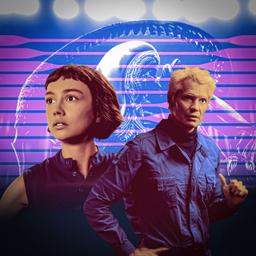The world of Alien: Earth is in many ways a wondrous one. In the year 2120, humanity has developed synthetics (artificially intelligent humanoid robots), cyborgs (cybernetically enhanced humans), and hybrids (human consciousnesses implanted into superpowered synthetic bodies, as a means of defeating death). Space commerce is common, cryosleep is routine, and first contact has occurred (quite painfully, for any humans who meet a Xenomorph). The FX series’ setting is unsettling and dystopian—it’s Alien, after all—but it’s also a vote of confidence in continued technological advancement. This vision of future Earth is, as one character in Episode 3 says, "full-on sci-fi."
As is often the case, though, the conventions of sci-fi dictate that, in some respects, the series should resemble the Earth of the 20th century more than that of the 22nd. Alien: Earth is far from the first spinoff whose fictional future looks like the past—and it won’t be the last. Because for better or worse, on-screen sci-fi is stuck in the ’70s.
The 1970s influence on Alien: Earth makes itself seen in the outfits, eyewear, and hairstyles of characters such as Dame Sylvia (Essie Davis) and her husband, Arthur (David Rysdahl), who tend to the synthetics for the series’ Prodigy Corporation. But it mainly manifests in the prequel’s production design. For all the technological terrors and marvels of Alien: Earth’s techno-capitalistic (or techno-feudalistic) society, its architecture and devices are stubbornly low-tech.
Gritty, grimy, industrial ships and buildings abound, as do analog gizmos and fuzzy CRT screens surrounded by physical buttons and dials and whirring, flashing indicators. In Episode 2, the trillionaire titans of Prodigy and the Weyland-Yutani Corporation video chat on handheld gadgets that look like portable media players from the mid-2000s. In Episode 3, another synthetic films the dissection of an alien egg with a bulky, wired camcorder. Wendy, the first of the synthetics, shocks onlookers by manipulating screens with her fingers, a functionality we take for granted today.
One could come up with in-universe explanations for this seemingly regressive preference for more tactile gear: greater reliability, repairability, or cost-effectiveness, perhaps, or a cyclical cultural rejection of the more minimalist, streamlined look that we associate with cutting-edge equipment today. The main reason, though, is that this is what the original Alien looked like.
Alien: Earth blends the claustrophobic scares of Ridley Scott’s 1979 franchise starter with the action and combat of James Cameron’s 1986 sequel, but aesthetically speaking, it’s more Alien than Aliens. Like Alien: Isolation and Alien: Romulus, it embraces that bedrock first film not just for timeline-related reasons—Alien: Earth takes place two years before Alien, so logically, it should look similar—but because Alien is iconic. The struggle for the soul of the franchise, which has gestated in several filmmakers and burst forth in multifarious forms, seems to be settled: Alien, the franchise, is now visually and tonally in lockstep with Alien, the foundational film.
Understandably, the franchise’s first foray into TV doesn’t dramatically redesign the titular alien, both because a Xenomorph makeover would break canon and because H.R. Giger’s nightmarish design is so inextricable from the franchise. Similarly, creator, showrunner, writer, and sometime director Noah Hawley maintains the sort of scenery and technology established by Scott, along with Alien’s Oscar-winning effects crew and Oscar-nominated art director, Michael Seymour, and set decorator, Ian Whittaker. Scott himself, as the driving force behind the franchise, took the creative liberty of updating Alien’s visuals to a sleeker, more futuristic style in his 2012 and 2017 prequels, Prometheus and Alien: Covenant, which also altered the Xenomorph’s origin story. But as Hawley told The Hollywood Reporter, he jettisoned those movies’ “less useful” and somewhat confusing lore and look in his show:
When you look at those first two movies, you have this retro-futuristic technology. You have giant computer monitors, these weird keyboards. … You have to make a choice. Am I doing that? Because in the prequels, Ridley made the technology thousands of years more advanced than the technology of Alien, which is supposed to take place in those movies’ future. There’s something about that that doesn’t really compute for me. I prefer the retrofuturism of the first two films. And so that’s the choice I’ve made—there’s no holograms. The convenience of that beautiful Apple store technology is not available to me.
Retro-futurism is one term for this template; cassette futurism is another. Closely aligned is the phrase “used future,” which was seemingly coined by George Lucas in 1977. “The trouble with the future in most futuristic movies is that it always looks new and clean and shiny,” Lucas said. “What is required for true credibility is a used future. The Apollo capsules were instructive in that regard. By the time the astronauts returned from the moon, you had the impression the capsules were littered with weightless candy wrappers and old Tang jars, no more exotic than the family station wagon. And although Star Wars has no points of reference to Earth … it is a decidedly inhabited and used time and place.”
Scott was inspired by Star Wars before he made Alien and (with legendary designer Syd Mead and visual effects supervisor Douglas Trumbull) 1982 cyber-punk trailblazer Blade Runner. Those three movies, released in a five-year span from 1977 to 1982, left a lasting stamp on science fiction: a worn, lived-in look that stands in contrast to the clean, stately majesty of Stanley Kubrick’s 2001: A Space Odyssey. Alien: Earth hearkens back to Blade Runner, too, in the echoes of the film’s replicant Roy Batty and the smoggy, rainy, neon-lit Los Angeles seen in the series’ synthetic Kirsh and city of New Siam, respectively.
The latest outgrowths of the franchises that flowed from those three formative films have unabashedly adhered to their predecessors’ visions of used futures and retro technology. As Hawley said of Alien: Earth, “Are we doing retrofuturism? Are we doing the cathode ray tube screens? Are we doing all of that stuff that in 1979 felt super futuristic, and to us now, feels like 1979? And the answer is: Of course we are. That is what Alien is.” That’s true whether the infested ship is named the Nostromo or the Maginot.
Blade Runner featured flying cars and human-replica robots, but also pay phones and printouts of photos. Its 2017 sequel, Blade Runner 2049, preserved that technological dichotomy, partly by blaming a lack of electronic records on an event called “the blackout.” “Sometimes I had a strange feeling that I was more doing a period movie than a sci-fi movie,” director Denis Villeneuve said. (Don’t be surprised to see more of the same in the next sequel, forthcoming TV miniseries Blade Runner 2099.)
In the Star Wars streaming universe, The Mandalorian leaned into the gritty, seamy side of the galaxy far, far away, and Andor employed practical effects in (accurately) aiming to be “earthy and raw.” In a Wall Street Journal story titled “How ‘Andor’ Designers Took ‘Star Wars’ Back to the Analog Era,” prop master Martyn Doust explained, “There’s no touching the screen. Everything is controlled by a big, chunky button or a dial.”
Thus, these recent extensions of almost-50-year-old franchises perpetuate paradoxes that stood out from the start: The Empire can construct Death Stars capable of destroying planets, and the Rebel Alliance can build starfighters capable of destroying Death Stars, but neither of them can create a targeting system that tops the vector graphics from the Star Wars arcade game. (Graphic design isn’t the Empire’s passion.) Similarly, Prodigy and Weyland-Yutani can work wonders we can only imagine, but their computers are limited to MS-DOS-style green-characters-on-black-background readouts that dominate the diegetic and nondiegetic text of Alien: Earth.
Further complicating these painstaking re-creations of past production designs is that these similar looks land differently today, when some of our real-life instruments seem more “sci-fi” than their fictional equivalents. In the late 1970s, the aesthetics of Star Wars and Alien weren’t really retro: They were more like present futurism, mixtures of contemporary and far-fetched, far-off tech. Plus, the tools used to make those movies’ magic—and that of cult-classic proofs of concept such as 1974’s Dark Star, cowritten by director John Carpenter and Alien writer Dan O’Bannon—were concessions to low budgets and abbreviated shoots.
As Doust told the Journal about the early architects of Star Wars, “They were using real-world stuff, taking it apart, and adding elements to make something look more technologically advanced than it actually was.” Now Doust and his counterparts on other IP—many of whom have huge budgets and ample time—are scrounging through decades of analog and digital detritus to try to find relics that can mimic the kludges of yesteryear. Those ’70s sci-fi landmarks were trying to fast-forward. In their urge to pay homage, today’s tentpoles are trying to rewind.
That “make sci-fi ’70s again” impulse can’t help but lead to less innovation in a narrow sense. On a visual level, at least, these prequels and sequels tend to be celebrated for their faithfulness more than their freshness. Is it bad to begin a new project by genuflecting at the altar of the old? It would seem so—yet Andor, Alien: Earth, and Blade Runner 2049 are all very good to great. They are, to some extent, prisoners to their origins’ fame, but Star Wars, Alien, and Blade Runner rule, and the nostalgia for those Mount Rushmore sci-fi films still hits hard. Plus, in an era of pervasive, often unconvincing CGI, there’s a throwback charm to any show or movie that roots its design in a time of tiny models, matte paintings, and puppets. And a visual debt doesn’t preclude other kinds of inventiveness.
It’s thrilling for fans to see new creations in the mold of old favorites, looking none the worse for wear. (Or, in “used future” sci-fi, looking worse for wear on purpose.) But in a sea of familiar-looking follow-ups, it’s easy to appreciate the reinvention of Predator, a series that started in the jungle of 1980s Central America but has lately proved portable to the early 18th-century Great Plains, 17th-century Japan, and 1940s North Africa. As long as they feature an eponymous Predator and some sympathetic prey, new installments in the series can play out in any period.
Star Trek, too, can’t quite be pinned down. Like Alien, Star Trek traces its cinematic premiere to 1979—but Star Trek debuted on the small screen in the ’60s. The Original Series looked so low-budget and campy that subsequent shows and movies—including those that have starred some of the same characters, such as Strange New Worlds—have had license to switch things up. (Even the infamous Gorn got a glow-up.) The makers of Star Trek have held the leash loosely when it comes to continuity, whether in the so-called Kelvin timeline of the J.J. Abrams reboot trilogy, the vast time jump of Discovery, or the Mirror Universe of (ugh) Section 31. New Star Trek doesn’t always look good, but it does look different. Andor’s excellence notwithstanding, Star Wars could benefit from exploring a new time period, which would lend itself to a new look.
There’s no slackening in the supply of on-screen sci-fi, and sequels and originals derived from ’70s or ’80s classics—also see Stranger Things, Skeleton Crew, and Paper Girls—aren’t the only kind in the pipeline. Dune: Prophecy, for instance, looks a lot like Villeneuve’s Dune, even though he didn’t end up directing any episodes of the series. Hollywood is all about brand names, so the sequels will keep coming, no matter how hoary the source material. When they do, they’re bound to bear resemblances to the things they’re spinning off from because studios can’t capitalize on known commodities if they don’t look like known commodities. Which means that some series will continue to cross sci-fi and That ’70s Show. And if they’re as good as Andor or Alien: Earth, we’ll watch anyway.




